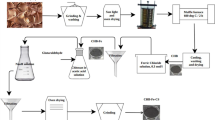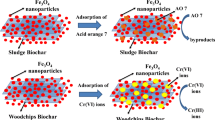Abstract
This study aims to explore heavy metal ion adsorbents with excellent removal performance. For this, chitosan and gelatin-based hydrogel beads (Hyb) were prepared and crosslinked with a nanocellulose structure using ammonium zirconium carbonate (AZC) and calcium chloride (Ca). The prepared hybrid aerogels, HybAZC and HybCa, were characterized by using various techniques to investigate their respective morphologies and functional groups for a better understanding of their capacity for heavy metal ion adsorption. Then, we systematically investigated the difference in removal and adsorption capacities of heavy metal ions for single and multiple ion cases using the prepared aerogels-HybAZC and HybCa. The tested heavy metal ions were Hg(II), Pb(II), Cd(II), and Cr(III) ions. For the adsorption systems with single ion (S-HybAZC and S-HybCa) cases, every single metal ionic solution was studied in the presence of the aerogels; but for the multiple ion (M-HybAZC and M-HybCa) adsorption systems, mixed metal ionic solutions with predetermined concentrations of four heavy metal ions were studied. In a single system using S-HybAZC and S-HybCa aerogels, the removal efficiencies of all metal ions except the Cd(II) ion (using S-HybCa) were calculated to be above 65%. In multiple systems, regardless of the quality or quantity of aerogels or metal ions, the removal efficiencies were calculated to be above 85%. Overall, results suggest the prepared aerogels HybAZC and HybCa can be employed as effective adsorbents for single and multiple systems. Thus, hybrid nanocellulose aerogels have great potential for practical applications in the removal of heavy metal ions.






Similar content being viewed by others
References
Zhang H, Xu F, Xue J, Chen S, Wang J, Yang Y (2020) Enhanced removal of heavy metal ions from aqueous solution using manganese dioxide-loaded biochar: Behavior and mechanism. Sci Rep 10:6067
Service RF (2006) Desalination Freshens Up. Science 313(5790):1088
Zhang F, Wang X, Yin D, Peng B, Tan C, Liu Y, Tan X, Wu S (2015) Efficiency and mechanisms of Cd removal from aqueous solution by biochar derived from water hyacinth (Eichornia crassipes). J Environ Manage 153:68–73
El Samrani AG, Lartiges BS, Villiéras F (2008) Chemical coagulation of combined sewer overflow: Heavy metal removal and treatment optimization. Water Res 42(4):951–960
Doke SM, Yadav GD (2014) Process efficacy and novelty of titania membrane prepared by polymeric sol–gel method in removal of chromium(VI) by surfactant enhanced microfiltration. Chem Eng J 255:483–491
Chang Q, Zhang M, Wang J (2009) Removal of Cu2+ and turbidity from wastewater by mercaptoacetyl chitosan. J Hazard Mater 169(1):621–625
Cavaco SA, Fernandes S, Quina MM, Ferreira LM (2007) Removal of chromium from electroplating industry effluents by ion exchange resins. J Hazard Mater 144(3):634–638
Chakraborty S, Dasgupta J, Farooq U, Sikder J, Drioli E, Curcio S (2014) Experimental analysis, modeling and optimization of chromium (VI) removal from aqueous solutions by polymer-enhanced ultrafiltration. J Membr Sci 456:139–154
Thaçi BS, Gashi ST (2019) Reverse Osmosis Removal of Heavy Metals from Wastewater Effluents Using Biowaste Materials Pretreatment. Pol J Environ Stud 28(1):337–341
Lee BG, Lee HJ, Shin DY (2005) Effect of Solvent Extraction on Removal of Heavy Metal Ions Using Lignocellulosic Fiber. Mater Sci Forum 486–487:574–577
Zhang L, Zeng Y, Cheng Z (2016) Removal of heavy metal ions using chitosan and modified chitosan: A review. J Mol Liq 214:175–191
Sud D, Mahajan G, Kaur MP (2008) Agricultural waste material as potential adsorbent for sequestering heavy metal ions from aqueous solutions – A review. Biores Technol 99(14):6017–6027
Karunanayake AG, Todd OA, Crowley M, Ricchetti L, Pittman CU, Anderson R, Mohan D, Mlsna T (2018) Lead and cadmium remediation using magnetized and nonmagnetized biochar from Douglas fir. Chem Eng J 331:480–491
Apiratikul R, Pavasant P (2008) Batch and column studies of biosorption of heavy metals by Caulerpa lentillifera. Biores Technol 99(8):2766–2777
Jusoh A, Shiung LS, Ali N, Noor MJMM (2007) A simulation study of the removal efficiency of granular activated carbon on cadmium and lead. Desalination 206(1):9–16
Kang KC, Kim SS, Choi JW, Kwon SH (2008) Sorption of Cu2+ and Cd2+ onto acid- and base-pretreated granular activated carbon and activated carbon fiber samples. J Ind Eng Chem 14(1):131–135
Al-Senani GM, Al-Fawzan FF (2018) Adsorption study of heavy metal ions from aqueous solution by nanoparticle of wild herbs. Egypt J Aquat Res 44(3):187–194
Zhang W, An Y, Li S, Liu Z, Chen Z, Ren Y, Wang S, Zhang X, Wang X (2020) Enhanced heavy metal removal from an aqueous environment using an eco-friendly and sustainable adsorbent. Sci Rep 10:16453
Perumal S, Atchudan R, Yoon DH, Joo J, Cheong IW (2019) Spherical Chitosan/Gelatin Hydrogel Particles for Removal of Multiple Heavy Metal Ions from Wastewater. Ind Eng Chem Res 58(23):9900–9907
Perumal S, Atchudan R, Yoon DH, Joo J, Cheong IW (2020) Graphene oxide-embedded chitosan/gelatin hydrogel particles for the adsorptions of multiple heavy metal ions. J Mater Sci 55(22):9354–9363
Daochalermwong A, Chanka N, Songsrirote K, Dittanet P, Niamnuy C, Seubsai A (2020) Removal of Heavy Metal Ions Using Modified Celluloses Prepared from Pineapple Leaf Fiber. ACS Omega 5(10):5285–5296
Liu Y, Lv X, Bao J, Xie J, Tang X, Che J, Ma Y, Tong J (2019) Characterization of silane treated and untreated natural cellulosic fibre from corn stalk waste as potential reinforcement in polymer composites. Carbohyd Polym 218:179–187
Alves L, Ferraz E, Gamelas JAF (2019) Composites of nanofibrillated cellulose with clay minerals: A review. Adv Colloid Interface Sci 272:101994
Rol F, Belgacem MN, Gandini A, Bras J (2019) Recent advances in surface-modified cellulose nanofibrils. Prog Polym Sci 88:241–264
Isogai A, Zhou Y (2019) Diverse nanocelluloses prepared from TEMPO-oxidized wood cellulose fibers: Nanonetworks, nanofibers, and nanocrystals. Curr Opin Solid State Mater Sci 23(2):101–106
Chen Xf, Ren Jl, Meng L (2015) Influence of Ammonium Zirconium Carbonate on Properties of Poly(vinyl alcohol)/Xylan Composite Films. J Nanomater 810464
Song D, Zhao Y, Dong C, Deng Y (2009) Surface modification of cellulose fibers by starch grafting with crosslinkers. J Appl Polym Sci 113(5):3019–3026
Mikula K, Skrzypczak D, Ligas B, Witek-Krowiak A (2019) Preparation of hydrogel composites using Ca2+ and Cu2+ ions as crosslinking agents. SN App Sci 1(6):643
Russo R, Malinconico M, Santagata G (2007) Effect of cross-linking with calcium ions on the physical properties of alginate films. Biomacromol 8(10):3193–3197
Saito T, Kimura S, Nishiyama Y, Isogai A (2007) Cellulose Nanofibers Prepared by TEMPO-Mediated Oxidation of Native Cellulose. Biomacromol 8(8):2485–2491
Lone S, Yoon DH, Lee H, Cheong IW (2019) Gelatin–chitosan hydrogel particles for efficient removal of Hg(ii) from wastewater. Environ Sci: Water Res Technol 5(1):83–90
Szekalska M, Sosnowska K, Czajkowska-Kośnik A, Winnicka K (2018) Calcium chloride modified alginate microparticles formulated by the spray drying process: A strategy to prolong the release of freely soluble drugs. Materials 11(9):1522
Song D, Breedveld V, Deng Y (2011) Rheological study of self-crosslinking and co-crosslinking of ammonium zirconium carbonate and starch in aqueous solutions. J Appl Polym Sci 122(2):1019–1029
Mikkonen KS, Schmidt J, Vesterinen A-H, Tenkanen M (2013) Crosslinking with ammonium zirconium carbonate improves the formation and properties of spruce galactoglucomannan films. J Mater Sci 48(12):4205–4213
Chieng BW, Lee SH, Ibrahim NA, Then YY, Loo YY (2017) Isolation and characterization of cellulose nanocrystals from oil palm mesocarp fiber. Polymers 9(8):355
Luo X, Wang X (2017) Preparation and Characterization of Nanocellulose Fibers from NaOH/Urea Pretreatment of Oil Palm Fibers. BioResources 12(3):5826–5837
Lu H, Zhang Q, Dong Y, Li J, Zhang X (2016) The Adsorption Capacity, Pore Structure, and Thermal Behavior of the Modified Clay Containing SSA. Adv Mater Sci Eng 2016:9894657
Marshall WE, Champagne ET, Evans WJ (1993) Use of rice milling byproducts (hulls & bran) to remove metal ions from aqueous solution. J Environ Sci Health Part A: Environ Sci Eng Toxicol 28(9):1977–1992
Sobhanardakani S, Parvizimosaed H, Olyaie E (2013) Heavy metals removal from wastewaters using organic solid waste—rice husk. Environ Sci Pollut Res 20(8):5265–5271
Dang VBH, Doan HD, Dang-Vu T, Lohi A (2009) Equilibrium and kinetics of biosorption of cadmium(II) and copper(II) ions by wheat straw. Biores Technol 100(1):211–219
Farajzadeh MA, Monji AB (2004) Adsorption characteristics of wheat bran towards heavy metal cations. Sep Purif Technol 38(3):197–207
Memon JR, Memon SQ, Bhanger MI, Memon GZ, El-Turki A, Allen GC (2008) Characterization of banana peel by scanning electron microscopy and FT-IR spectroscopy and its use for cadmium removal. Colloids Surf B 66(2):260–265
Mondal DK, Nandi BK, Purkait MK (2013) Removal of mercury (II) from aqueous solution using bamboo leaf powder: Equilibrium, thermodynamic and kinetic studies. J Environ Chem Eng 1(4):891–898
Ekebafe LO, Ekebafe MO, Erhuaga GO, Oboigba FM (2012) Effect of reaction conditions on the uptake of selected heavy metals from aqueous media using composite from renewable materials. Am J Polym Sci 2(4):67–72
Van Tran T, Bui QTP, Nguyen TD, Le NTH, Bach LG (2016) A comparative study on the removal efficiency of metal ions (Cu2+, Ni2+, and Pb2+) using sugarcane bagasse-derived ZnCl2-activated carbon by the response surface methodology. Adsorpt Sci Technol 35(1–2):72–85
Zhang G, Qu R, Sun C, Ji C, Chen H, Wang C, Niu Y (2008) Adsorption for metal ions of chitosan coated cotton fiber. J Appl Polym Sci 110(4):2321–2327
Acknowledgements
The authors are very grateful to the Ministry of Trade, Industry and Energy – South Korea for providing financial support (Grant No. 10067082). This research was partially supported by the National Research Foundation of Korea funded by the Ministry of Education, Science, and Technology (2012M3A7B4049677 and 2020R1I1A3074491).
Author information
Authors and Affiliations
Corresponding authors
Ethics declarations
Conflict of interest
There are no conflicts to declare.
Additional information
Publisher's Note
Springer Nature remains neutral with regard to jurisdictional claims in published maps and institutional affiliations.
Rights and permissions
About this article
Cite this article
Perumal, S., Lee, H., Jeon, S. et al. Synthetization of hybrid nanocellulose aerogels for the removal of heavy metal ions. J Polym Res 28, 325 (2021). https://doi.org/10.1007/s10965-021-02693-w
Received:
Accepted:
Published:
DOI: https://doi.org/10.1007/s10965-021-02693-w




